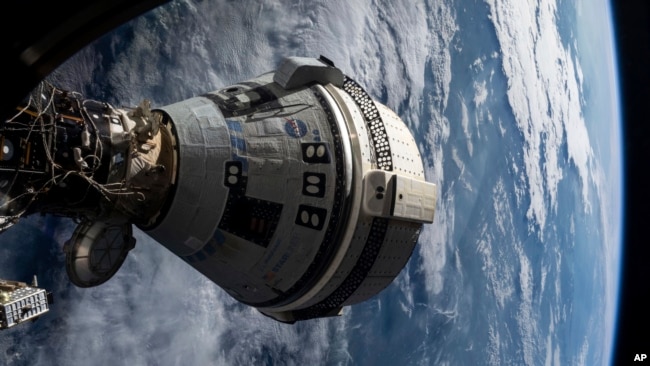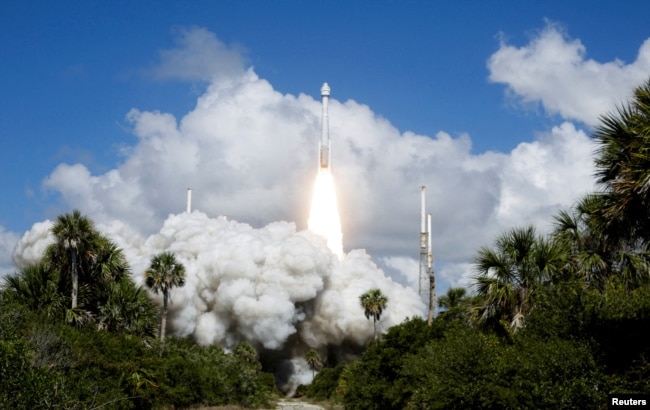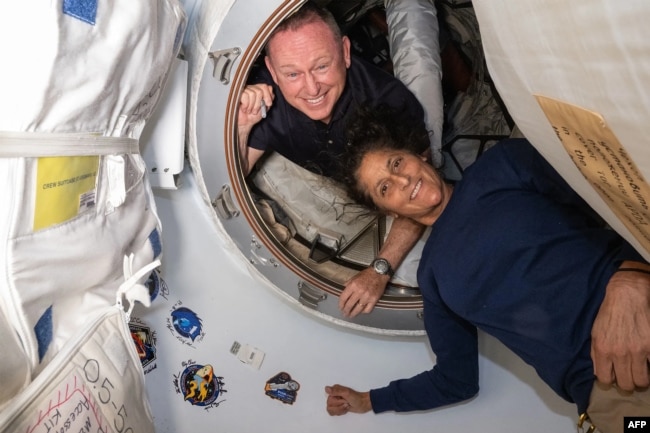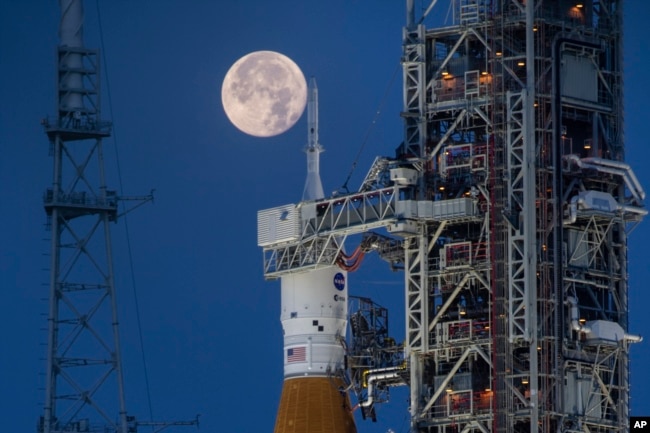今や浪漫ではなく、宇宙開発は国を揚げたミッションであり、一般人にとっても現実になろうとする夢でもあります。
しかしながらその開発コストたるや莫大!!
イーロン・マスク氏はすごいなあぁ、とかボーイング社の困難な状況なのだなぁとか思った次第です。
日本も国としてもっとバックアップしなければですね。
なかなか長いバージョン。お付き合いください。
- Experts Question Boeing's Space Business after Starliner Failures
- スターライナーの失敗でボーイングの宇宙事業に疑問を呈する専門家たち(和訳)
Experts Question Boeing's Space Business after Starliner Failures
Experts and people in the space industry say NASA's decision to send Boeing's Starliner capsule home without astronauts was not unexpected. They also said it follows years of problems with Boeing’s space business.
Taking NASA astronauts Butch Wilmore and Suni Williams to the International Space Station (ISS) was supposed to have been a turning point for Starliner. The operation had suffered years of delays and technical problems.
Reuters news agency examined financial securities reports for Boeing and reported on what it had found. Reuters estimated that Starliner has cost Boeing $1.6 billion in cost overruns since 2016.
The Starliner spacecraft was launched from Cape Canaveral, Florida, on June 5. Astronauts Wilmore and Williams were to stay at the ISS for about eight days. But problems with Starliner have extended that NASA mission to eight months.
Starliner's propulsion system failed, and NASA judged the thrusters were not safe to attempt a return to Earth with a crew.
Instead, NASA announced that a SpaceX Crew Dragon capsule will return Wilmore and Williams to Earth in early 2025. SpaceX, led by Elon Musk, is the other company that NASA has contracted to develop crewed space vehicles. The June mission was meant to be a final test for NASA to approve Starliner for normal spaceflights.
Questions for Boeing and its leadership
Boeing's new leader Kelly Ortberg now must decide whether to continue developing the program or sell it. Ortberg also faces problems from failures by the company’s airplane manufacturing business.
NASA administrator Bill Nelson said he spoke to Ortberg recently. Nelson reported that the talk left him completely sure that Starliner would fly astronauts again.
Reuters asked Boeing representatives if the company would stay in the program after Starliner's current operation. A Boeing spokesperson chose not to comment on the question, telling Reuters that the company is centering its attention on getting the spacecraft back safely.
"I am not sure the decision will ultimately be NASA's," said Lori Garver. Garver is a former NASA deputy administrator and a main designer of NASA's Commercial Crew Program.
Ortberg started as Boeing’s leader on August 8. He is trying to persuade Boeing workers, investors, airlines and the public that safety problems at the company are now under control.
Experts say Boeing will probably keep Starliner in operation. They say this is partly because Boeing has experienced similar cost overruns in its defense business.
In the future, Starliner could serve customers other than NASA. These could include operators of private space stations meant to replace the ISS after 2030.
NASA faces decisions
NASA considers Boeing an important backup to Musk's SpaceX.
Boeing has spent more than half of its $4.5 billion NASA contract, which was given in 2014. Starliner has not yet received certification, or final approval for normal use. The contract includes six Starliner missions after the capsule is certified. Although the contract has a fixed price, NASA increased its value by $300 million.
SpaceX's Crew Dragon was certified in 2020. It has carried out 10 missions for NASA with a crew. The company’s first contract was worth $2.6 billion. NASA bought more Crew Dragon missions to take the place of Boeing's delayed missions. As a result, the value of SpaceX’s contract rose to $4.9 billion.
Boeing may have to carry out the same astronaut mission to the ISS again in order to get NASA certification for the capsule. The company already had to repeat an uncrewed 2022 mission at a cost of nearly $500 million. It has been five years since Starliner's first uncrewed test failed because of several important software problems.
In 2019, NASA's inspector general’s office estimated both companies’ cost per mission. It said Crew Dragon's mission price of carrying one astronaut into space was about $55 million while Starliner's cost was $90 million.
Questions about workforce and suppliers
For years, Boeing's space business has been losing skilled employees. Many former employees joined competitors SpaceX and Jeff Bezos' Blue Origin. Ten people who spoke to Reuters and who worked for Boeing’s space business said the company's structure made designing spacecraft more complex than it is for SpaceX.
Boeing, in a statement to Reuters, said the company is proud of its Starliner workforce. It also said that it has admitted problems with its workforce and with suppliers when reporting on its earnings to shareholders.
Throughout Starliner's development, the propulsion system and sometimes the software have failed. New problems were found just hours before the spacecraft made its first attempt to launch this summer. Helium gas, used to pressurize the propellant, was leaking through a small opening.
NASA considered the leak low risk. The agency permitted Starliner to launch. But officials said the propulsion system had a "design vulnerability" that Boeing must deal with before its next mission.
The Space Launch System, or SLS, is another problem for Boeing's space division. The SLS is expected to be the launch vehicle for America’s program to return to the moon. But the program has faced years of delays and is billions of dollars over budget.
NASA's inspector general’s August report said there were deep problems with quality control at Boeing. The report added that Boeing's SLS workforce in Michoud, Louisiana, lacks enough "aerospace production experience, training, and instruction."
A Boeing representative said the company disagrees with much of the report, "including any suggestion that our Michoud workforce is unqualified."
Unlike Starliner, NASA pays the cost of delays and development problems with SLS. Inspector general reports have repeatedly said that the cost overruns are not fully known because NASA does not account for them correctly.
NASA is trying to give ownership of SLS to Boeing and co-contractor Northrop Grumman to bring the costs down. However, experts say such a deal is unlikely.
Richard Aboulafia is an aerospace business adviser. He said Boeing's other businesses are strong, but he wonders about its space division. He thinks Ortberg will negotiate with NASA to make Starliner workable. However, he is not persuaded that that move is the right one.
"If I were an adviser to Kelly Ortberg, which I'm not, I'd say...for space, well boss, you might want to consider selling it," Aboulafia said.
Words in This Story
capsule – n. a part of a spacecraft that carries astronauts or the most important equipment in the vehicle system
overrun –n. a situation when more money is needed to complete a project than had been planned
mission –n. a space flight (or an official task) which as a specific set of goals and requirements
propulsion –n. a system that causes a vehicle to move
thruster –n. a device that helps control a spacecraft in space
backup –n. another choice that can be used if something fails
vulnerability –n. a weakness
instruction –n. things that need to be taught to a person so they can complete a task
スターライナーの失敗でボーイングの宇宙事業に疑問を呈する専門家たち(和訳)
専門家や宇宙産業関係者は、NASAがボーイングのスターライナー・カプセルcapsuleを宇宙飛行士抜きで帰還させる決定を下したことは、予想外ではなかったと語っています。また、ボーイングの宇宙事業における長年の問題に続くものだとも述べています。
NASAの宇宙飛行士ブッチ・ウィルモア氏とサニ・ウィリアムズ氏を国際宇宙ステーション(ISS)に運ぶことは、スターライナーにとって転機となるはずでした。この事業は何年も遅れと技術的な問題に苦しんでいました。
ロイター通信はボーイングの有価証券報告書を調査し、その結果を報道しました。ロイターは、スターライナーは2016年以降、ボーイング社に16億ドルのコスト超過overrunsをもたらしたと推定しています。
スターライナー宇宙船は6月5日にフロリダ州ケープカナベラルから打ち上げられました。宇宙飛行士のウィルモア氏とウィリアムズ氏はISSに約8日間滞在する予定でした。しかし、スターライナーの問題により、そのNASAのミッションは8カ月に延長されました。
スターライナーの推進propulsionシステムが故障し、NASAは乗組員とともに地球への帰還を試みるにはスラスターthrusters (宇宙船をコントロールする装置)が安全でないと判断しました。
代わりにNASAは、スペースX社のクルー・ドラゴン・カプセルが2025年初頭にウィルモア氏とウィリアムズ氏を地球に帰還させると発表しました。イーロン・マスク率いるスペースX社は、NASAが有人宇宙船の開発を請け負っているもうひとつの会社です。6月のミッションは、NASAがスターライナーを通常の宇宙飛行に承認するための最終テストという意味合いがありました。
ボーイングとそのリーダーシップへの疑問
ボーイングの新しいリーダーであるケリー・オートバーグ氏は、このプログラムの開発を継続するか、売却するかを決めなければなりません。オルトバーグ氏はまた、同社の航空機製造事業の失敗による問題にも直面しています。
NASAのビル・ネルソン長官は、最近オルトバーグと話をしたと述べています。スターライナーが再び宇宙飛行士を飛ばすことを完全に確信したと言べました。
ロイターはボーイングの担当者に、スターライナーの現在の運用が終了した後も、同社がこの計画にとどまるかどうかを尋ねました。ボーイングの広報担当者は、この質問にはコメントせず、同社は宇宙船を安全に帰還させることに集中しているとロイターに語りました。
「最終的にNASAが決定するかどうかはわかりません」とロリ・ガーバー氏話します。ガーバー氏は元NASA副長官で、NASAのコマーシャル・クルー・プログラムの主要設計者です。
オルトバーグ氏は8月8日にボーイングのリーダーに就任しました。彼は、ボーイングの従業員、投資家、航空会社、そして一般市民を説得し、同社の安全問題は現在コントロール下にあることを示そうとしています。
専門家によれば、ボーイング社はおそらくスターライナーの運航を続けるだろうとのことです。その理由のひとつは、ボーイングが防衛事業で同様のコスト超過を経験しているからだと言います。
将来的には、スターライナーはNASA以外の顧客にも提供される可能性があります。2030年以降にISSの代わりとなる民間宇宙ステーションの運営者も含まれるかもしれません。
NASAは決断を迫られている
NASAは、ボーイングをマスクのスペースXの重要なバックアップと考えています。
ボーイングは2014年に与えられた45億ドルのNASA契約の半分以上を費やしています。スターライナーはまだ認証、つまり通常の使用に対する最終承認を受けていません。契約には、カプセルが認証された後の6回のスターライナー・ミッションが含まれています。この契約は固定価格ですが、NASAは3億ドル増額しました。
スペースX社のクルー・ドラゴンは2020年に認証されました。NASAのためにクルーを乗せて10回のミッションを実施しています。同社の最初の契約額は26億ドルでした。NASAはボーイングの遅れたミッションの代わりにクルー・ドラゴンのミッションを買い増しました。その結果、スペースX社の契約額は49億ドルに増加しました。
ボーイングは、カプセルのNASA認証を得るために、同じ宇宙飛行士によるISSへのミッションを再び実施しなければならないかもしれません。同社はすでに、5億ドル近い費用をかけて2022年の無人ミッションを繰り返さなければなりませんでした。スターライナーの最初の未搭乗テストが、いくつかの重要なソフトウェアの問題のために失敗してから5年が経ちました。
2019年、NASAの監察総監室は両社のミッションあたりのコストを試算しました。それによると、宇宙飛行士1人を宇宙に運ぶクルー・ドラゴンのミッション価格は約5,500万ドルであるのに対し、スターライナーのコストは9,000万ドルでした。




